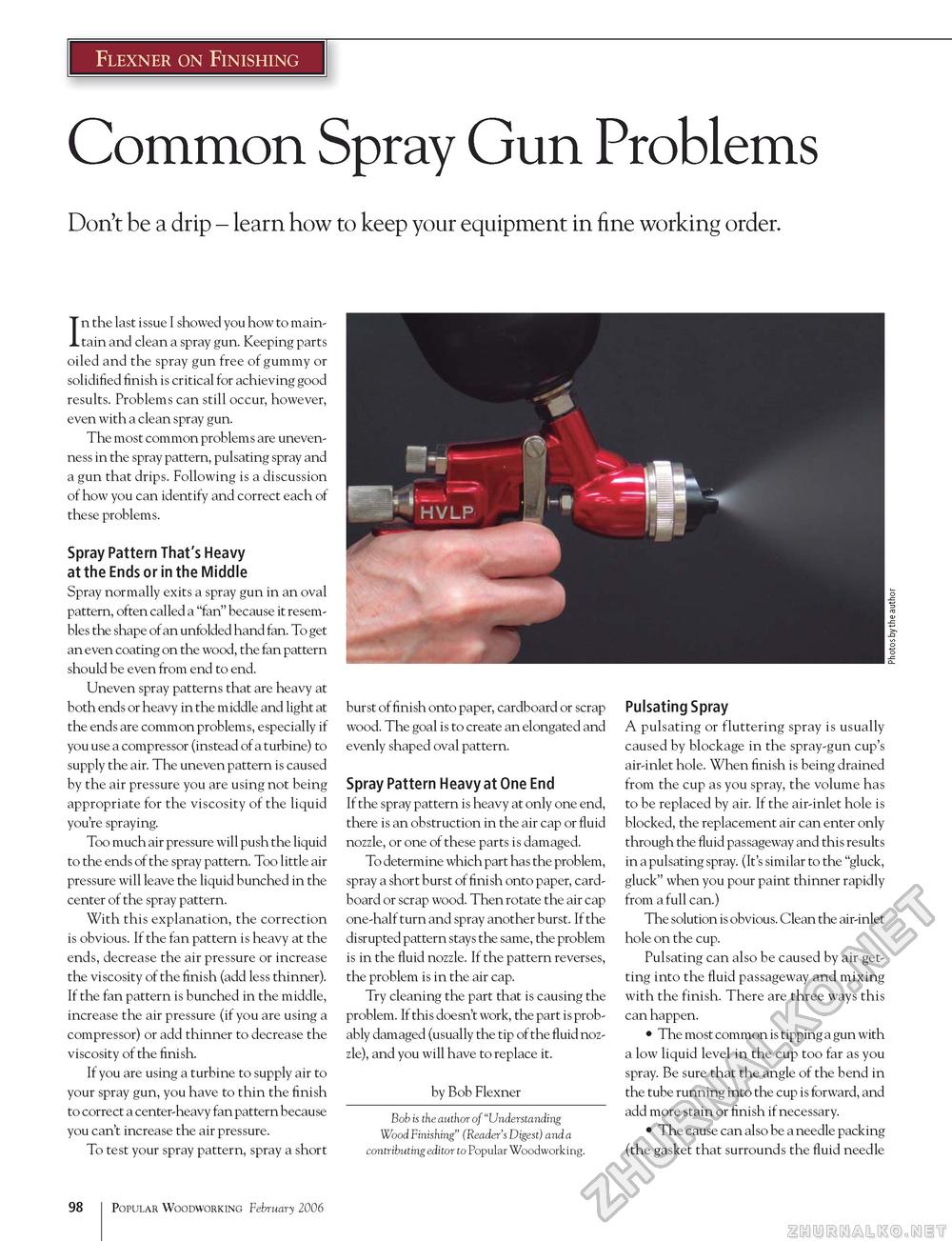Popular Woodworking 2006-02 № 153, страница 97
Flexner on Finishing Common Spray Gun Problems Don't be a drip - learn how to keep your equipment in fine working order. In the last issue I showed you how to maintain and clean a spray gun. Keeping parts oiled and the spray gun free of gummy or solidified finish is critical for achieving good results. Problems can still occur, however, even with a clean spray gun. The most common problems are uneven-ness in the spray pattern, pulsating spray and a gun that drips. Following is a discussion of how you can identify and correct each of these problems. Spray Pattern That's Heavy at the Ends or in the Middle Spray normally exits a spray gun in an oval pattern, often called a "fan" because it resembles the shape of an unfolded hand fan. To get an even coating on the wood, the fan pattern should be even from end to end. Uneven spray patterns that are heavy at both ends or heavy in the middle and light at the ends are common problems, especially if you use a compressor (instead of a turbine) to supply the air. The uneven pattern is caused by the air pressure you are using not being appropriate for the viscosity of the liquid you're spraying. Too much air pressure will push the liquid to the ends of the spray pattern. Too little air pressure will leave the liquid bunched in the center of the spray pattern. With this explanation, the correction is obvious. If the fan pattern is heavy at the ends, decrease the air pressure or increase the viscosity of the finish (add less thinner). If the fan pattern is bunched in the middle, increase the air pressure (if you are using a compressor) or add thinner to decrease the viscosity of the finish. If you are using a turbine to supply air to your spray gun, you have to thin the finish to correct a center-heavy fan pattern because you can't increase the air pressure. To test your spray pattern, spray a short burst of finish onto paper, cardboard or scrap wood. The goal is to create an elongated and evenly shaped oval pattern. Spray Pattern Heavy at One End If the spray pattern is heavy at only one end, there is an obstruction in the air cap or fluid nozzle, or one of these parts is damaged. To determine which part has the problem, spray a short burst of finish onto paper, cardboard or scrap wood. Then rotate the air cap one-half turn and spray another burst. If the disrupted pattern stays the same, the problem is in the fluid nozzle. If the pattern reverses, the problem is in the air cap. Try cleaning the part that is causing the problem. If this doesn't work, the part is probably damaged (usually the tip of the fluid nozzle), and you will have to replace it. by Bob Flexner Bob is the author of "Understanding Wood Finishing" (Reader's Digest) and a contributing editor to Popular Woodworking. Pulsating Spray A pulsating or fluttering spray is usually caused by blockage in the spray-gun cup's air-inlet hole. When finish is being drained from the cup as you spray, the volume has to be replaced by air. If the air-inlet hole is blocked, the replacement air can enter only through the fluid passageway and this results in a pulsating spray. (It's similar to the "gluck, gluck" when you pour paint thinner rapidly from a full can.) The solution is obvious. Clean the air-inlet hole on the cup. Pulsating can also be caused by air getting into the fluid passageway and mixing with the finish. There are three ways this can happen. • The most common is tipping a gun with a low liquid level in the cup too far as you spray. Be sure that the angle of the bend in the tube running into the cup is forward, and add more stain or finish if necessary. • The cause can also be a needle packing (the gasket that surrounds the fluid needle 98 Popular Woodworking February 2006 |








